|
| |
| Jazz Accordion
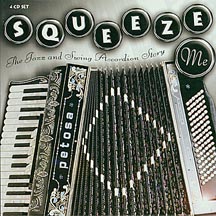 The
accordion is a portable, freely vibrating reed instrument. It consists
of a keyboard and bass casing that are connected by a collapsible
bellows. Within the instrument are metal reeds, which create sound when
air, generated by the movement of the bellows, flows around them and
causes them to vibrate. The accordion is constructed from hundreds of
pieces, and much of it is hand assembled. First constructed in the early
nineteenth century, the accordion continues to evolve into an ever more
versatile instrument. The
accordion is a portable, freely vibrating reed instrument. It consists
of a keyboard and bass casing that are connected by a collapsible
bellows. Within the instrument are metal reeds, which create sound when
air, generated by the movement of the bellows, flows around them and
causes them to vibrate. The accordion is constructed from hundreds of
pieces, and much of it is hand assembled. First constructed in the early
nineteenth century, the accordion continues to evolve into an ever more
versatile instrument.
The accordion (the Italian name "fisarmonica"
is derived from the German word "Physharmonikaz," a compound name coming
from the Greek word "Physa" - bellows - and "Harmonikos" - harmonic) is
a musical instrument operated by air pressure, belonging to the family
of the aerophones. It consists of three different parts: the right hand
keyboard for the melody, the bellows, and the left hand keyboard (or
buttons) for the accompaniment.
The accordion's sound is produced by the
reed, a small metal plate on which a thin steel strip is mounted that
oscillates with the movement of the air produced by the compression of
the bellows. The following three models are the most popular accordion
types: on the "diatonic" model, the sound produced when the bellows are
opened is different to that produced when they are closed; the
"chromatic" model allows the complete range of twelve sounds to be
played (this model also has "buttons" on the right hand keyboard); the
"piano" accordion has a right hand keyboard that is very similar to a
piano keyboard, with black and white keys.
The accordion, an instrument very close
to the heart of generations of Italians, is a masterpiece of fine
mechanics (the more familiar keyboard of a typewriter is nothing
compared to the mechanism which works the bass and chord valves) and of
fluid dynamics Oust think of the air tightness of the bellows and of the
valves that open and close the access of air into the reeds), consisting
of some hundreds of pieces built from a variety of materials, such as
fir, maple, mahogany and walnut wood; metals such as steel, hard
aluminium and brass; precious cashmere, felt and cloth, as well as
lamb's hide, kid and leather; celluloid, rubber and virgin wax.
|
Jazz
Accordion
At the turn of the
twentieth century, the accordion was used primarily in orchestral groups,
although it also had its niche role in the ragtime genre. The pioneers of this
early movements are Charlie Creath (who actually played a number of instruments)
and the Italian-American Tito Guidotti. In neither case, however, we can talk
about jazz yet.
Significant appearances of the accordion took place in this period thanks to Joe
Smelser and Charles Magnante, two swing soloists who played in very prestigious
orchestras, including those of Benny Goodman and Duke Ellington. More or less
all of the musicians mentioned above preferred a style ranging from the musette
(a term which indicates a specific French accordion style) to the swing which
was at its most popular in this period.
Other important artists of the time include Gus Viseur, Toni Murena and Joe
Privat.
In Italy the jazz accordion is historically confined to the work of Gorni
Kramer, a swing accordionist whose contribution was picked up, among others, by
Wolmer Beltrami and
Peppino Principe. The most
important contribution to the modernization of the instruments was given by June
Garner and Alice Hall (1917). The latter, Belgian by birth, might be considered
the first "be-boy" accordionist, having played with Dizzy Gillespie and Charlie
Parker, and was famous for the amazing energy that she used to put in her
improvisations.
This takes us to the first real exponents of the jazz accordion era, and who
deserve this label due to the fact that they were real leaders, capable of
drawing to this newly introduced instrument a range of musicians of great
calibre. The accordionists in question are Art Van Damme and Mat Mathews.
Van Damme recorded more than forty albums, and still plays live from time to
time, while Mathews, the least "be-boy" of the two, heralded a style of evident
Californian origins. Both accordionists have played with jazz musicians of
international stature, including Joe Venuti, Archie Shepp, Kenny Clarke, Art
Farmer and many others.
Italian-French accordionist Richard Galliano is currently the prime exponent of
the jazz accordion world. His main merits consist in the ability of finding a
balance between tradition and innovation, and of mixing several different
genres: from French musette to Argentinean tango (which he knows full well,
having been a student of Astor Piazzolla's), all filtered through his
extraordinary virtuoso skills and trademark accuracy. The jazz accordion scene
in Italy is currently represented by the opposing styles of
Gianni Coscia and Antonello Salis.
Coscia, formerly a student of
Gorni Kramer's, has largely drawn from the accepted academic tradition of
accordion interpretation; while Salis has taken a much more non-conformist
approach to his style of jazz accordion and piano performance, and his moulding
these instruments to his artistic goals.
The considerable distance that still separates traditional and avant-garde
musicians suggests that the possibilities of the accordion within this musical
genre are still largely to be explored.
|
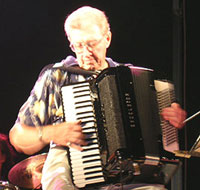 The
hippest cat ever to swing an accordion, The
hippest cat ever to swing an accordion,
Art Van Damme
dared go where no man had gone before: jazz accordion. He started taking
accordion lessons at the age of nine, and moved on to classical studies
after his family moved to Chicago, Illinois, in 1934. After leaving
school. he played in a trio in local clubs under big band leader Ben
Bernie hired him in 1941. He soon returned to Chicago, though, and
continued to work the club circuit there throughout World War Two.
Van Damme was inspired by swing recordings,
particularly Benny Goodman's, and in the late 1930s, he began
experimenting, adapting Goodman solos to the accordion. Throughout his
career, he would often be compared to Goodman, since the two were both
classically trained, technical masters of their instruments, and
versatile and creative jazz soloists. He formed a quintet with several
of his studio colleagues, and recorded his first album, for the small
label, Music Craft, in 1944.
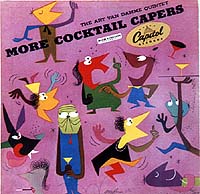 He
joined the staff of NBC Radio in Chicago in 1945 and remained a studio
musician for over 15 years, even after he became a recording artist in
his own right. His early style fits into a small but at the time quite
popular niche between the cocktail piano sound and the
accordion/guitar/organ sound of the Three Suns. In fact, his earliest
albums for Capitol and Columbia all had titles that made this connection
explicit: "Cocktail Capers"; "Martini Time"; "Manhattan Time." He
joined the staff of NBC Radio in Chicago in 1945 and remained a studio
musician for over 15 years, even after he became a recording artist in
his own right. His early style fits into a small but at the time quite
popular niche between the cocktail piano sound and the
accordion/guitar/organ sound of the Three Suns. In fact, his earliest
albums for Capitol and Columbia all had titles that made this connection
explicit: "Cocktail Capers"; "Martini Time"; "Manhattan Time."
Despite liner notes that described this music as
"background for badinage," these are excellent albums, if far more
subdued that the bebop they shared the record bins with. Van Damme's
introduction of the accordion as a featured jazz instrument was
well-received critically, and in 1947, Downbeat magazine put his
photo on the cover of one of their issues. He would go on to voted "Top
Accordionist" in Downbeat's annual poll of jazz musicians for ten
years in a row. Later, he was similarly recognized by Contemporary
Keyboard magazine for five years in a row.
As time went on, Van Damme moved into more
adventurous territory, closer to mainstream jazz. His later Columbia
albums feature him at the lead of small, tight combos, and include a mix
of standards and Van Damme's own slightly bebop-ish originals.
"Accordion a la Mode" may be his best album, although "A Perfect Match,"
in which he pairs with the fine jazz guitarist Johnny Smith, is a
favorite among fans of what's been called "light jazz."
Van Damme never had a problem finding a gig, and
performed at clubs and hotels throughout Europe and the U.S. Over the
course of over fifty years of performing, he traveled to Europe nearly
40 times and played everywhere from the Desert Inn in Las Vegas, to the
Blue Note in New York, to Disney World in Florida. He also appeared on
numerous television shows, from "The Tonight Show" to "The Dinah Shore
Show." In the early 1950s, his quintet also recorded over 130 15-minute
segments for NBC Radio. He claims that his performing kept him so busy
he never needed to practice, and says that he probably played his
accordion at home less than six hours total in all that time.
After leaving NBC Radio in 1960, Van Damme opened a music store and
accordion studio in Chicago, but he continued to tour regularly. He left
the recording mainstream when his contract with Columbia Records ran out
in 1965, but was quickly signed by the German jazz label, MPS, and went
on to record 16 albums for them. Since 1980, he has recorded less
frequently, usually for small jazz labels, including an excellent album
with the group Singers Unlimited on the Pausa. He gradually shifted his
focus from clubs to accordion and jazz workshops, telling one interview
that, "The audience is more attentive and listens more intensely."
Although a number of other accordionists ventured into jazz territory
after Van Damme broke the trail, he remains the acknowledged master. As
one reviewer recently wrote, he dispatches "Right-hand runs with a
velocity and lightness of touch that defied the presumed limitations of
the instrument," while at the same time, "Consistently emphasizing the
lyric contours of a melodic phrase rather than the lightning technical
flourishes that led up to it."
He eventually retired to Florida. He announced at his 75th birthday
party that he intended to hang up his squeezebox for good, telling one
interview that he felt like he'd played enough for one lifetime
Frank
Marocco
was born in Illinois and grew up in the
town of Waukegan, a suburb of Chicago. When he was seven years old, his
parents enrolled him in a six-week trial program on the accordion.
His first instructor, George Stefani, was a source of inspiration to
him. Marocco studied with him for nine years. His training was in the
classics but his teacher encouraged him to explore other areas: he
played the piano and the clarinet, he studied music theory, harmony,
conducting, and he was a member of his high school band.
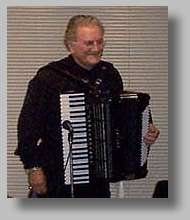
The next year, he studied with the legendary Andy Rizzo,
a master teacher who has influenced many of this country's accordion
artists. At age 17, Marocco took first place in a national music
contest, performing his winning solo with the Chicago Pops Orchestra for
a huge crowd at Chicago's Soldier's Field.
This might have encouraged
him to see a full-time career in music. He formed a trio which went on
tour in several Midwestern states. During his travels, he met his future
wife, Anne, in South Bend, Indiana. Together they decided to head west
to make their home in the Los Angeles area.
Marocco organized a new group which toured the hotel and club circuit of
Las Vegas, Lake Tahoe, and Palm Springs. But Hollywood was beckoning.
Being close to the movie and the TV studios offered opportunities never
available in the Midwest. He was launched on an unbelievable career -
the list of his credits
is endless. Highlights: Travelling with Bob Hope visiting the
servicemen in many countries; being featured on the Les brown Band,
including six Love Boat cruises. More recently, he has been very busy
with studio work: movie soundtracks, TV movies, TV series , records and
advertising jingles. Along the way, he has managed to find time to
compose and arrange both jazz and classical music. |
 Pete
Watson - Accordion Pete
Watson - Accordion
Pete enjoys Jazz, French and Eastern Music and has travelled extensively playing
the accordion. Pete met up with Ultraswing in 2000 and has collaborated with
other groups such as Vipers Dream, Balkanatics and Yash Bash. Pete teaches
accordion and piano in schools whilst spending his spare time helping to run the
Crypt Jazz Club in London and Stage Two at Ealing Jazz
Festival. Pete teaches Piano and Accordion
Jo Privat and Gus Viseur
Accordionists accompanied Django Reinhardt.
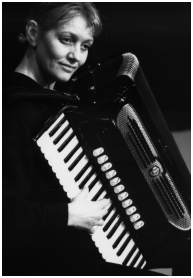 Karen
Street - Somerset based
accordionist has worked with the cream of contemporary British jazz artists from
Tim Garland's Lammas, numerous Mike Westbrook projects to Phil Robson's Octet.
Her reputation as a jazz accordionist and composer is firmly established with
'Accordion Crimes', her second CD of original compositions and arrangements. The
accordion is much-maligned, the butt of many a musicians' joke, however Karen,
as one of the best of the latest generation of virtuoso accordionists will
convert you to the particular charms of this most expressive of keyboard
instruments. Her music is a characteristic blend of jazz, flavoured with folk,
full of subtlety and passion. "Musicians who have given the accordion a genuine
voice are rare, but Karen Street is undoubtedly one of them" - John
Fordham, Jazz UK. Karen
Street - Somerset based
accordionist has worked with the cream of contemporary British jazz artists from
Tim Garland's Lammas, numerous Mike Westbrook projects to Phil Robson's Octet.
Her reputation as a jazz accordionist and composer is firmly established with
'Accordion Crimes', her second CD of original compositions and arrangements. The
accordion is much-maligned, the butt of many a musicians' joke, however Karen,
as one of the best of the latest generation of virtuoso accordionists will
convert you to the particular charms of this most expressive of keyboard
instruments. Her music is a characteristic blend of jazz, flavoured with folk,
full of subtlety and passion. "Musicians who have given the accordion a genuine
voice are rare, but Karen Street is undoubtedly one of them" - John
Fordham, Jazz UK.
Karen started the accordion
at the age of eight only because her big brother was having lessons, however it
quickly turned into a passion and the highlight of her week became playing with
the local accordion band which ploughed relentlessly through pieces like
Sibelius’ Finlandia, Leroy Anderson tunes and selections from the musicals. At
the same time she took up the saxophone, playing in the local jazz band.
She followed the accepted path for any budding accordionist and worked the
accordion competition circuit (a bit like Come Dancing with squeeze boxes)
becoming the British Virtuoso Champion in 1981/2, and consequently competing in
the Coupe Mondiale (World Championship) in Hamburg and Folkestone.
At that time the world of the classical contemporary accordion was very limited,
so Karen turned to the saxophone and found herself in an all girl saxophone
quartet 'The Fairer Sax' who appeared on television and radio and at festivals
all over the world.
In 1992 she was invited to join Mike Westbrook’s big band on saxophone and
accordion and has since been involved in many of his projects - the latest being
“Chanson Irresponsable”. Further invitations from Tim Garland led to tours with
“Lammas”, his project “Songs of Love and Liberty” and more recently in his "Made
by Walking " tour playing alongside Geoff Keezer Joe Locke and Avishai Cohen .
Other credits include, Phil Robson Octet, Steve Arguelles, Martha Lewis - Café
Aman, and Roy Nathanson
Karen has always been a composer and arranger and in particular has written many
works for the saxophone. Her catalogue now extends from solos to large
ensembles, many of which are published by Boosey & Hawkes, June Emerson and
Saxtet Publications. Her pieces appear in virtually every music exam syllabus in
the UK. Inevitably she turned her compositional skills to the accordion and
finished up with her debut album - “Finally a Beginning”. This collection of
compelling compositions range in style from contemporary jazz to folk and tango
reflecting her diverse musical influences. One of the compositions on the CD "In
the Ballroom with the Rope" took first prize at the London Accordion Festival,
Composition Competition in 2001.
She has just recorded another CD again featuring Stan Sulzmann and Fred T Baker,
with a guest appearance from Mike Outram on guitar.
She also co-runs Saxtet with Andy Tweed her husband. This contemporary saxophone
quintet uniquely has five composer/performers. Karen's material is very much at
the heart of the group.
Karen’s accordion is a free bass accordion in which the bass has a range of five
octaves unlike the limited standard bass of the Stradella bass accordion.
This freedom allows her to play melody, harmony and bass lines that has not been
widely explored on the instrument -
her latest CD
'Accordion Crimes!
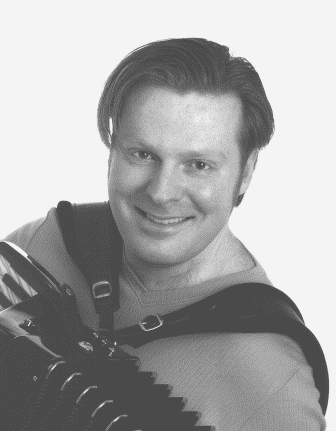 Shane
Brogan comes from the west coast of Scotland where he was born along with
his twin brother in 1971. His late father, Neil Brogan, who played the
accordion, was a huge influence on the young boy’s desire to play. So with his
mother’s encouragement, he began to study the accordion at the age of nine with
his teacher,
Jim Hutcheon,
who is a fine musician from Ayr. Shane
Brogan comes from the west coast of Scotland where he was born along with
his twin brother in 1971. His late father, Neil Brogan, who played the
accordion, was a huge influence on the young boy’s desire to play. So with his
mother’s encouragement, he began to study the accordion at the age of nine with
his teacher,
Jim Hutcheon,
who is a fine musician from Ayr.
Shane went on to study music at Napier University
of Edinburgh, where he graduated with a diploma in music, specialising in
the accordion, piano and composition. He was the very first accordionist ever to
be accepted by the university. Whilst studying in Edinburgh, he
enrolled on to
Tommy Smith’s
"Jazz Creative Improvisation" course. This was the catalyst that
encouraged him to develop his talent more seriously within jazz. Shane finally
graduated from the pioneering jazz school,
The National Jazz Institute of Scotland,
under the directorship of Tommy Smith – the world-renowned tenor saxophonist.
Again, Shane was the first accordionist to have ever studied there.
More recently, Shane has established his own music
business, which involves performing, teaching, composing, arranging, recording,
writing, copying, publishing and producing, etc., as well as his very own music
school,
The Shane Brogan School of Music.
His future ventures include, performing, recording and touring.
Shane Brogan plays a specially custom
made accordion, courtesy of Pigini, Castelfidardo, Italy and uses a W.E.M. "Shane
Brogan Special" accordion and midi amplifier, courtesy of W.E.M.
Limited, London, United Kingdom
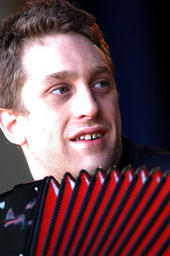 Martin
Green Born into a family of
traditional music and trained by one of the contemporary accordion world’s most
respected teachers (Alberto Santilly) Martin had a good grounding in numerous
styles and techniques at an early age, including time in Hungary with legendary
gypsy violinist Janos Lang. Soon after finishing school (with great grades
in music) Martin joined Eliza Carthy, princess of English Folk, with whom he
would work for several years; recordings included ‘Red Rice’ (Mercury prize
short list) and ‘Angels and Cigarettes’, culminating in a critically-acclaimed
Carthy-Green duo album (‘Dinner’) featuring JC001 (Nitin Sawhney) and Eddi
Reader (Fairground Attraction). Over the past few years many of the great names
of English and American folk have called upon Martin’s talents: extensive world
touring with Joan Baez, Linda Thompson and The Be Good Tanyas, recording
sessions and performances with Roger McQuinn (The Byrds), Hugh Cornwall (The
Stranglers), Norma Waterson, Kathryn Tickell, Karine Polwart and many others. Martin
Green Born into a family of
traditional music and trained by one of the contemporary accordion world’s most
respected teachers (Alberto Santilly) Martin had a good grounding in numerous
styles and techniques at an early age, including time in Hungary with legendary
gypsy violinist Janos Lang. Soon after finishing school (with great grades
in music) Martin joined Eliza Carthy, princess of English Folk, with whom he
would work for several years; recordings included ‘Red Rice’ (Mercury prize
short list) and ‘Angels and Cigarettes’, culminating in a critically-acclaimed
Carthy-Green duo album (‘Dinner’) featuring JC001 (Nitin Sawhney) and Eddi
Reader (Fairground Attraction). Over the past few years many of the great names
of English and American folk have called upon Martin’s talents: extensive world
touring with Joan Baez, Linda Thompson and The Be Good Tanyas, recording
sessions and performances with Roger McQuinn (The Byrds), Hugh Cornwall (The
Stranglers), Norma Waterson, Kathryn Tickell, Karine Polwart and many others.
Martin’s talent as a composer has
been kept busy also. 2003 brought work as composer and musical director of
‘Albatross’, a vast environmental theatre show, which after successful
performances throughout England became the centre piece of Glastonbury
festival’s outdoor theatre field. In 2004 Martin co-wrote the score for a stage
adaptation of ‘The Little World of Don Camillo’ with Scottish trumpeter Colin
Steele (BBC jazz award winner, best album). This year Martin was awarded a
prestigious ‘New Voices’ commission for young composers by Glasgow’s Celtic
Connections festival. That piece, which will feature ten musicians and live
electro-acoustic elements, premieres in Jan 2006 at Glasgow Royal Concert Hall.
Martin moved to Edinburgh in 2004
and has become a mainstay of both the traditional music scene and Edinburgh’s
unique jazz/folk crossover music. Crossover projects have including traveling to
Canada with folk big band The Unusual Suspects and touring in Europe with Salsa
Celtica. Within the traditional music sphere recently-formed trio Lau sees Green
teamed up with fiddle hero Aidan O’Rourke (Blazin’ Fiddles, Karine Polwart) and
guitarist Kris Drever (Kate Rusby, John McCusker). Work with drummer John Rae’s
band Celtic Feet has included music for the dance show ‘Off Kilter’ and
collaboration with Hungarian Gypsy musicians Robbi and Mihaly Farkas. Producer
and composer Jim Sutherland (The Lanterns, Page and Plant) employed Martin’s
skills with keyboards and laptop electronics for his commissioned audio-visual
work ‘Cold Weather Dancing’ and to play accordion and organ on the score for the
feature film ‘Festival’.
2005 will see the release of
‘Return To The Woods’, the long-awaited album from a duo project with violin
virtuoso Joe Townsend. It also sees the formation of ‘The Green Machine’, an
outlet for Martin’s original compositions – a shit-kicking art band with a huge
sound and a large line-up including a brass section led by Rick Taylor (Elton
John, George Michael), vocals from Sophie Bancroft and Inge Thomson, guitar and
live sampling wizard Tom Cook (aka Manni), and realtime breakbeat and tuck-u-up
groove from young Scottish drummer Alyn Cosker (Ryan Quigley Quintet). The Green
Machine recently received funding from the PRS foundation and will begin
recording their debut release in September.
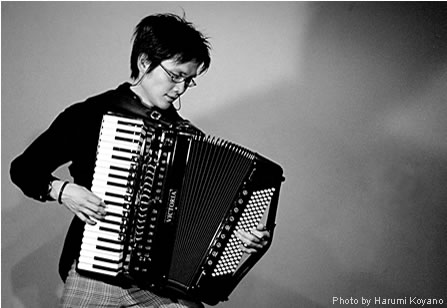 Yoshiaki
Sato Yoshiaki
Sato
Check out
Artist: Tetsuro Kawashima Sax with
Yoshiaki
Album: Reason Of Reeds
Label: MYCJ 30393
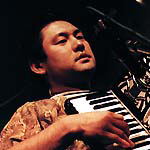 Yuichi Ohtsuka
Yuichi Ohtsuka
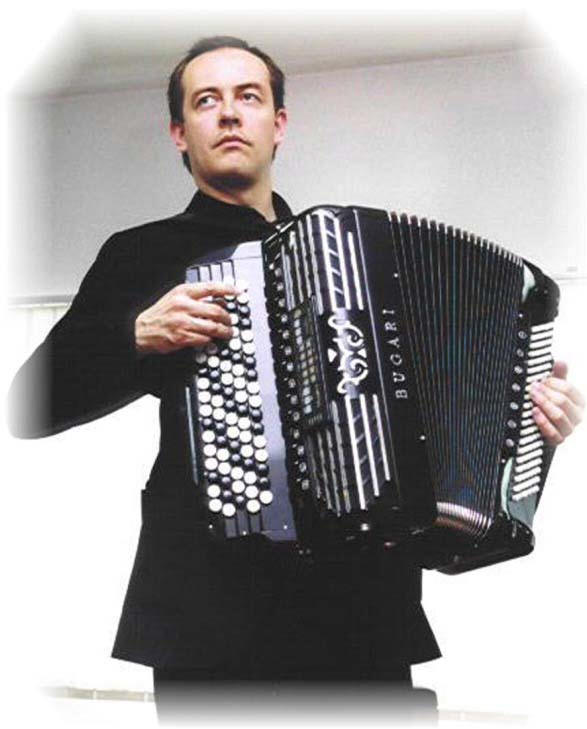 Stien
Carstensen
was born in Eidsvoll. He started as an accordion player at the age of 9. He
first learned from his father, and later from a classical player which he
attended for 4 years. During this time he played in Norwegian tv, radio,
festivals etc. He also toured in America, playing classical music. At the same
time he was also into swing jazz, and his father who also played bass, played
standard tunes with him. Stien
Carstensen
was born in Eidsvoll. He started as an accordion player at the age of 9. He
first learned from his father, and later from a classical player which he
attended for 4 years. During this time he played in Norwegian tv, radio,
festivals etc. He also toured in America, playing classical music. At the same
time he was also into swing jazz, and his father who also played bass, played
standard tunes with him.
When he was 15 he started to play electric guitar in a
rock band. After a while he started to get back the interest for jazz again and
formed a trio with some local artists. He lived as a freelancer a year or so and
then he began to study in the conservatory in Trondhiem jazz department with the
guitar as a main instrument. During his two years of study in Trondheim
(1991–93), he formed the group
Farmers Market. The group
was originally a free jazz quintet, until they one day found a note with a
Bulgarian folk tune in 11/16. This was a great experience for the band members
and they practiced day and night to be able to play this asymmetrical music.
After a while Stian went to Bulgaria and visited villages
there to collect and study the local folk music. The result of the tour was a
live record, Speed/Balkan/Boogie, with singers & musicians from the famous "Le
mysteres des voix bulgares" recorded at Molde international jazz festival in
Norway. After this Stian was totally dedicated to the Bulgarian music. He toured
a lot with musicians from Bulgaria, and Romania, and learned a lot from them.
Besides of being dedicated to this kind of music, he also
took lessons in Composition, learned to play the 5-string Banjo in Bluegrass
style, played with various jazz groups (be-bop, and experimental) with
Jon Christensen and Bendik
Hofseth to mention some.
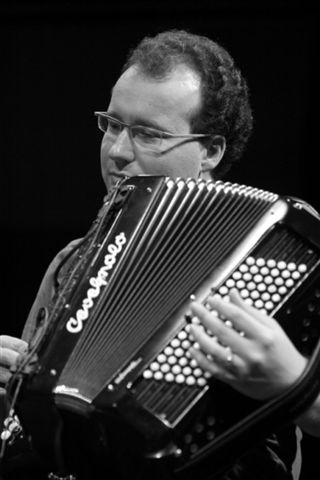 Ludovic
Beier - Only
29 years old, he is playing on the French and European scene with some of the
top players of the Django/Swing Jazz style including Angelo Debarre, Dorado
Schmitt, Florin Niculescu…He certainly is giving the accordion a new name as his
fingers go across the keys in an almost unbelievable way, both swinging and
amazingly creative in his improvisation. Along with his virtuoso playing, he
composes and arranges, and has his own band, Ludovic Beier Quartet, to perform
his "cool and latin" French jazz. He has an impressive technique and also a
great dose of lyricism with a band that keeps him at full stretch. Accordion
will never be the same under his knowledgeable hands, and the new directions he
takes. Besides playing around Europe at top festivals and clubs, he appeared in
the States with the Django Reinhardt Project, performing at Birdland (NYC) with
guests such as Paquito D'Rivera, at Lincoln Center with Joe Lovano, at Yoshis
(CA) with David Sanchez, and last summer at the Montreal International Jazz
Festival with Angelo Debarre and James Carter where he brought the house down.
He also had the honour to perform at Carnegie Hall with Toots Thielemans among a
prestigious line up including Herbie Hancock, Ivan Lins and Eliane Elias. Ludovic
Beier - Only
29 years old, he is playing on the French and European scene with some of the
top players of the Django/Swing Jazz style including Angelo Debarre, Dorado
Schmitt, Florin Niculescu…He certainly is giving the accordion a new name as his
fingers go across the keys in an almost unbelievable way, both swinging and
amazingly creative in his improvisation. Along with his virtuoso playing, he
composes and arranges, and has his own band, Ludovic Beier Quartet, to perform
his "cool and latin" French jazz. He has an impressive technique and also a
great dose of lyricism with a band that keeps him at full stretch. Accordion
will never be the same under his knowledgeable hands, and the new directions he
takes. Besides playing around Europe at top festivals and clubs, he appeared in
the States with the Django Reinhardt Project, performing at Birdland (NYC) with
guests such as Paquito D'Rivera, at Lincoln Center with Joe Lovano, at Yoshis
(CA) with David Sanchez, and last summer at the Montreal International Jazz
Festival with Angelo Debarre and James Carter where he brought the house down.
He also had the honour to perform at Carnegie Hall with Toots Thielemans among a
prestigious line up including Herbie Hancock, Ivan Lins and Eliane Elias.
Jazz Accordion Playing
Hi - I stumbled upon your website.
I've been playing the piano accordion 120 bass for about 2 years.
Is there an accordion made somewhere with a bass button-board that does not
follow the circle of 5ths ?
In my mind, I visualize a
BASS
button-board that has a
linear
progression of buttons (of the scale):
C - C# - D - D# - E - F - F# - G - G# - A - A# - B.
I think that would make playing jazz a little easier - especially when we have
to follow sharps and flats in rapid succession.
Any comments would be appreciated - reply to
Mel Rapp
re
your question:
There is no Stradella bass system that I know of that does not do the cycle of
fifths, but there are free bass accordions which follow the pattern you
mentioned. They are usually called converters, where three or four rows of the
Stradella bass converts to free bass (single notes) I use free bass all the time
when playing jazz and most classical accordion players use this system as it
gives greater freedom. Hope this helps.
Karen Street
Stradella
Keyboard System
|